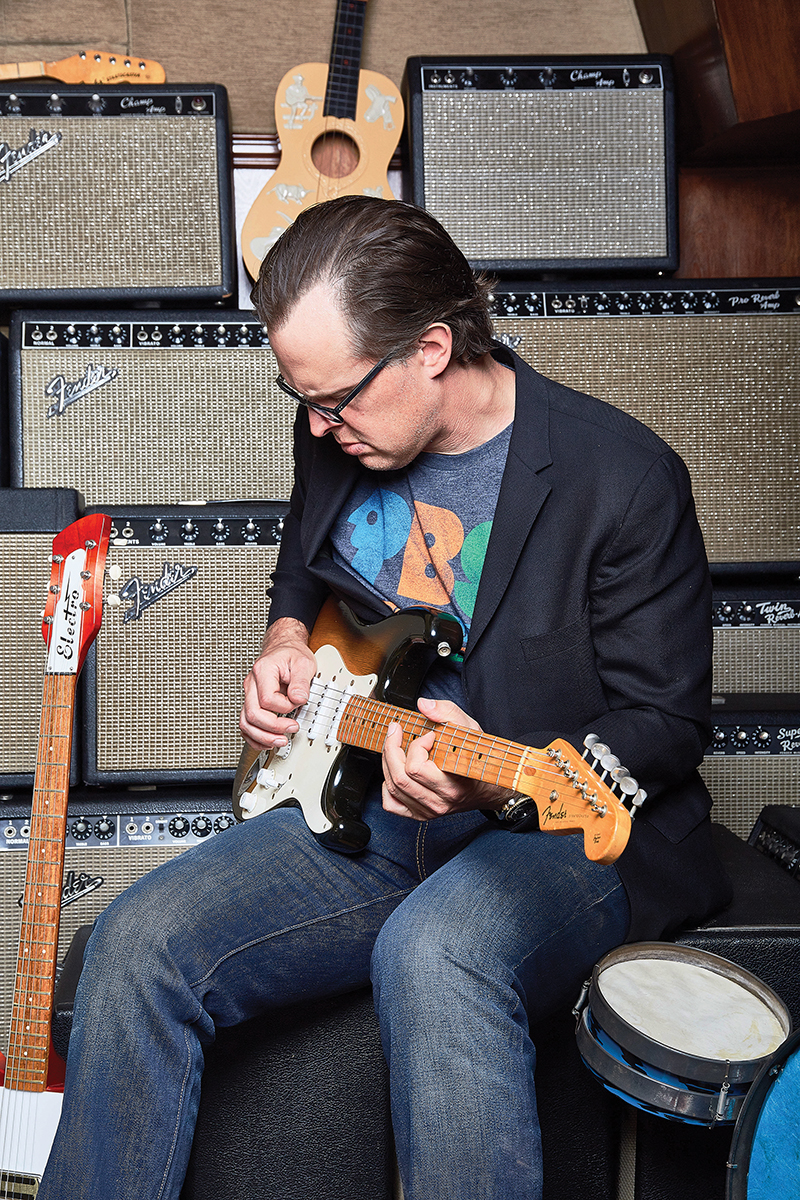Interview: Joe Bonamassa – Redemption Songs
During the recording sessions for his diverse new studio album, Joe Bonamassa found out that the road to Redemption isn’t always easy, and that sometimes even the curator of one of the world’s foremost guitar collections can’t get the tone he wants…

Portraits Jen Rosenstein
Joe Bonamassa’s latest solo studio album, his 13th in 18 years, contains a rich collection of music that ranges from Zeppelin-style pomp to mellow introspection via Chicago Blues, the Tulsa Sound and plenty more besides. We catch up with him on the road in Nebraska and he reveals that, although Redemption was tracked over a year ago, this latest long-player is “really indicative” of what his band – augmented by several backing singers and horn players – is doing live these days.
“It was fun to make a record with our singers and horns as an entity,” Joe remembers. “It was a band record, more so than just ‘cut it as a three-piece and add’. It was nice to have everybody on it.”
For the Redemption sessions, in addition to drummer Anton Fig, bassist Michael Rhodes and former Double Trouble keys player Reese Wynans (for whom Bonamassa has recently produced an album loaded with special guest cameos), producer Kevin Shirley also threw legendary Nashville session guitarists Kenny Greenberg and Doug Lancio into the mix.
“It’s actually kind of liberating,” remarks Joe. “They were the colour. There’s a reason why these guys are studio legends, because they play the right stuff. They’d basically stay out of my lane going, ‘Look at him over there, he’s got tonnes of guitars, he plays too loud, too many notes, but there’s nothing we can say or do to talk him off the ledge!’”
Although Bonamassa’s live band has featured an additional guitarist in the past, he’s acutely aware of what his audience wants and is currently touring without a dedicated rhythm player: “We had Kirk Fletcher play with us in 2015 and he was great, but when we revert back to sludgy blues-rock, I take up so much fucking space, I feel bad for the rhythm guitar player because sonically, I’m just a bull in a china shop. That’s what they pay to see – subtlety be damned at eight o’clock!
“I used to get really up my own ass about it and think about being subtle or defaulting to the more well-worn paths or just playing less, you know? That’s cool but what I’ve found is, the people who like my music and come to my shows, they don’t wanna see that.
“We’ve been playing stuff off the new record for four or five months now – It was a new year so I thought I owed the fans some new songs, we tour relentlessly – and we’ve been doing this song called Just ‘Cos You Can Don’t Mean You Should. I way overplay on this song live, but people love it. I’m just long past the point of questioning that kind of thing now. If people clap and they like it, I feel like I’ve done my job.”

Treble Trouble
Bonamassa’s lead work on Redemption is characterised by explosive passages of fiery abandon. It turns out that this was often borne out of frustration more than design: “It was weird as I was having a hard time,” he recalls. “The bulk of the main sessions for the record we recorded in Nashville last July – I won’t tell you which studio – and I was having the hardest time with the guitar sound.
“I’ve recorded at least three studio albums – four if you count Black Coffee, that last record that we did with Beth [Hart] – with the same rig, essentially. Four Twins, or two Bassmans and two Twins, basically just the tweed amps. I always bring the usual suspects. It’s like, let’s start there before we get creative, guitar-wise. You bring your good Les Paul, your favourite Strat, your favourite Tele… stuff that has been on albums before that has stayed in tune and performed well before. I always default to that, because every time you make a record you start at zero, in my opinion.”
Despite the presence of proven workhorses and his favoured tweed-powered rig, back in the control room, things were far from rosy: “I go back in and I’m listening to it and I’m thinking, ‘Why does this sound like the amplifiers have no gain, and they have like a pillow on top?’ Snakebite and Skinner were there, there was a 1960 Burst, there was a Flying V there, my go-to Strats, Teles and stuff like that… but it didn’t matter what I plugged into it, it all sounded like Herb Ellis with a 175 and the tone rolled off. I’m like, ‘It’s killing me!’ It’s great if you are playing Herb Ellis but if you are playing blues-rock it’s not strident enough.”
Despite simplifying the signal chain, they were still having problems: “So I’m getting this shit from the engineer, and they’re like, we have you running through this and that… I said, ‘Pull all that shit out. Do me a favour, pull it all out.’ All of a sudden it started to kind of open up and I’m like, ‘See, that’s the sound!’ And then track after track, after track, I’m really struggling. In the headphones it sounded fine. In the control room, Kevin and I were going, ‘Man, this really sounds dull!’ And I’ve got the High Power [Twins] on the bright channel, with the presence almost all the way up, the treble all the way up. Man, these things are peeling paint in the room!
“They kept blaming the old gear, or it’s this, it’s that. I’m like, ‘I don’t mean to sound arrogant, but I will… I’ve done a few albums this fucking year with this rig, and it’s not what it sounds like!’ We never managed to get it sorted out, and it was really a buzzkill. I was like, ‘Kevin, do we have this?’ I was thinking I’d have to go back and recut all the guitars, ’cause it didn’t sound like me, in spite of my best efforts. So some of the things when I listen back, I think the performances were affected by what I was hearing or what I was not hearing. And it was kind of a bummer, you know?”
Clear The Desk
Eventually Bonamassa and Shirley figured out that it was actually the monitoring section of the studio mixing desk that was colouring the sound: “We have our own mics that this guy in South Africa makes for us called Tul [www.tulmicrophones.com]. They’re on the amps now, right here in Omaha. When you put the fader up, it sounds like the amp. Every time. I have one in my studio bag. It’ll sound like the amp, guaranteed, you don’t have to mess with it. But it got to the point where we were putting 57s on it, we were putting Beyers on it, Neumanns… nothing.
“And we figured out that it was the new API console. The monitoring section has its own kind of colour to it. In the studio I just want them to give me what the amp is doing. And not to sound bourgeoisie but that’s why the Neve console is the best for that – especially guitar-wise. If you have a shitty guitar sound then the Neve is gonna give you the best representation of that shitty guitar sound. There’s a reason why Rupert Neve is such a legend. I’d never really figured that out until I’d had three and a half weeks literally struggling, to say the least, with something that I’ve always taken for granted.”

Volume Wars
Studio lessons learned, we imagine that one of the busiest musicians in the business has a few tips for dealing with the challenges of live performance, too, from bad monitoring to overzealous sound engineers who insist on low stage volume levels.
“Here’s the thing I’ve always found with singing, here’s the trick,” says Joe. “If you’re ever in a situation where the monitors are so bad that they are hurting more than they are helping, turn ’em off. Just use the PA. Sometimes if wedges have limiters on them, or if they are EQ’d poorly or if they don’t have enough headroom or whatever, it’s actually singing with less, it vacuums sound out. You are better off just turning them off and using the force.”
Returning to the subject of paint-peeling volume, it seems that Bonamassa could be the main to front the campaign to reclaim ‘loud’ for guitarists. “When did the guitar become the Typhoid Mary of instruments?” he laughs, exasperated. “When did loud guitars become an open sewer in the pristine wilderness of rock ’n’ roll? When did that happen?! Now it’s like, ‘Oh no no, don’t even use a fucking amp!’ A Champ is too loud here. Let’s use a POD or a Fractal. When did it happen? How did it go from Jimi Hendrix with three stacks, all on, to ‘a Fender Princeton is too loud’? I can’t get my head around it. It’s almost laughable. Drummers are behind Plexiglas, everything is isolated.
“To me it doesn’t sound better. It makes a band play differently. It sounds like robots. It’s the same in the studio, where everything has to be so isolated, and engineers will high-five themselves, going ‘there’s not a stitch of bleed on this track.’ Then you’re going, ‘there ain’t a stitch of soul on this.’ All of my favourite records have shit everywhere. Mistakes. Out of tune vocals. Guitars that are everywhere, bass that’s everywhere. It’s great!” Amen to that.
Joe Bonamassa’s new album, Redemption, is released by Provogue/Mascot Label Group on 21 September.
